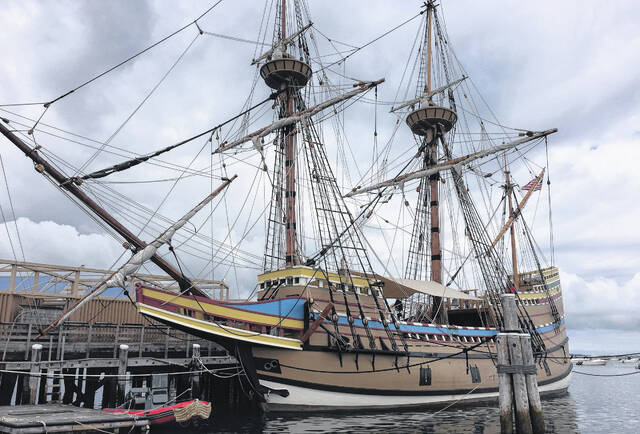
The Mayflower II in Plymouth Harbor, MA. The fate of the original Mayflower is unknown, although it is speculated that she was scrapped for timber to use for barns.
NEWBERRY — On September 6, 1620, the Mayflower set sail for America, leaving from Plymouth, England, and hoping to reach the Hudson River.
The passengers lived on the ship a month and a half before leaving. The original plan had been for the Mayflower to set sail alongside another ship named the Speedwell, leaving from South Hampton in late July. The Speedwell, who had picked up pilgrims from Delfthaven, reported they had been dealing with leaks. They spent six weeks patching the ship before they set sail on Aug. 5. Two more times did the ships have to turn around and return to England since the Speedwell had continuous leaks that they were unable to repair.
The cargo from the Speedwell was moved onto the Mayflower, along with a number of passengers. Others, frustrated with the problems they faced, decided to return home. Nevertheless, on Sept. 6, the Mayflower began her 66 day long journey to northern Virginia.
The first half of the journey was smooth sailing, the only major problem being sea sickness. But, by October, problems began to arise. The ship was met with a number of Atlantic storms, leaving the Mayflower to drift where the weather took her since it was too risky to use the sails. One storm damaged one of the ship’s support beams, but luckily the passengers had a great iron screw that helped raise the beam back into place.
Another storm sent John Howland off the deck. His life was saved by quick reaction and the other passengers when he grabbed one of the ships lines as he fell and being pulled back onto deck. Only one person died on the whole trip; a William Button, who died of unknown causes three days before the ship spotted land. On the opposite side of death, Elizabeth Hopkins gave birth on the voyage to her son, Oceanus.
After 66 days, on Nov. 11, the Mayflower arrived to Cape Cod. Although it was not the intended destination, they decided to drop anchor in what is now Provincetown since trying to sail south, to the Hudson, almost resulted in a shipwreck.
For a month and a half the pilgrims explored Cape Cod, searching for a place to begin their colony. On Dec. 25, they decided on Plymouth and began the construction of buildings, sailing back and forth to the Mayflower as the constructed what would soon be their new home.
Plymouth is still a town today, known for Plymouth Rock, a large stone with “1620” inscribed into it, as well Plymouth Patuxet Museum; a 17th century English village with pilgrim reenactors. There is a marker on Leyden Street, identifying the location where the first houses were built in 1620.
Reach Orion Griffin @ 803-768-3122 or on Twitter @TheNBOnews.
